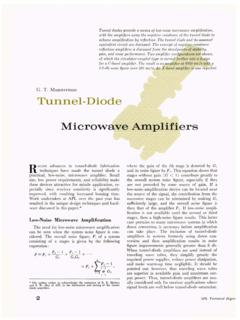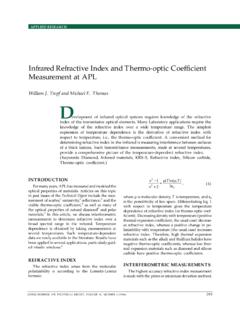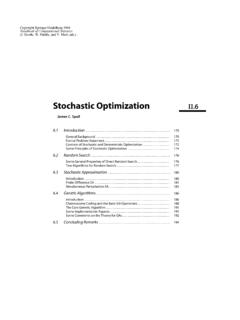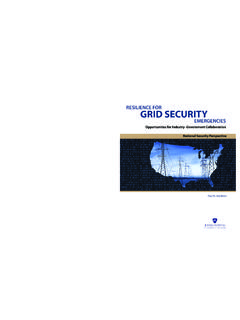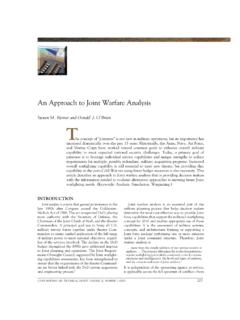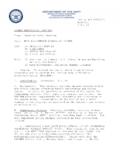Transcription of Ship Self-Defense System Architecture
1 536 JOHNS HOPKINS APL TECHNICAL DIGEST, VOLUME 22, NUMBER 4 (2001)536 36 JOHNSPPTShip Self-Defense System ArchitectureLarry S. Norcutthe ship Self-Defense System (SSDS) was devised to provide self -protection and combat System capability to non-Aegis ships of the Navy. This automated combat direction System uses many commercial hardware and software elements to achieve the first Navy distributed processing combat System , integrating already developed weapon and sensor systems. The SSDS Architecture was an innovation and somewhat of a risk, but well justified in light of its successful development and the continued benefits it has shown. The SSDS Mk 1 is currently operational on 11 Navy LSDs and its bigger variant, Mk 2, is well under development for the Navy s newest aircraft carrier and ship class. SSDS Architecture concepts have succeeded in advancing both the state of the art and the tactical capabilities of the primary mission of the LSD (landing ship , dock) class of Navy ships is to support amphibious assault conveying and landing Marine troops onto potentially hostile shores.
2 With the increasing capabilities of the anti- ship missile threat and the likelihood of Navy combat operations in the near-shore littoral regions came the requirement to significantly improve the Self-Defense capabilities of this ship class. In effect, the ships needed an automated Combat Direction System (CDS), smaller in scale than that of primary combatants such as destroyers, cruisers, and carriers, but highly capable of the detect, control, and engage functions necessary for by budget and time constraints, Navy efforts focused on the automation, optimization, and integra-tion of existing weapons and sensors to more effectively defend the ship . The resultant automation and inte-gration, performed by a networked set of commercial computers and operator displays, was named the ship Self-Defense System (SSDS) Mk 1. The new SSDS design incorporated lessons learned from over 20 years of experience in Navy tactical soft-ware and sensor integration development, and applied those lessons to the particular characteristics of combat System data and processing needs in an open- Architecture distributed-processing commercial-off-the-shelf (COTS) environment.
3 This included interfaces, processors, data distribution, computer languages, operating systems, dis-plays, software design concepts, and sensor integration concepts. The software Architecture was based on many years of experience dealing with Navy combat systems, and on ship Self-Defense studies performed by APL in the 1980s as part of the NATO Anti-Air Warfare (AAW) Program. SSDS Mk 1 formed the basis of the SSDS Mk 2 System currently in development. This larger variant adds JOHNS HOPKINS APL TECHNICAL DIGEST, VOLUME 22, NUMBER 4 (2001) 537536 J5 OHNSPONOK5OJ5I5 AOLJTEC36 AOCADEOto the baseline Self-Defense capabilities to encompass more of the traditional shipboard combat System func-tions such as air control and tactical data links. The Mk 2 has a bigger role as the tactical combat System for the Navy s newest aircraft carrier USS Ronald Reagan (CVN 76) and the developing landing ship , platform class USS San Antonio (LPD 17). The same basic archi-tectural concepts apply to both SSDS OF COMBAT DIRECTION System SOFTWAREThe first Navy computer programs were developed in the early 1960s primarily to support manual operator functions ( , track plotting and track symbol display) and to send surveillance data to other ships (Fig.)
4 1). Computer functions provided bookkeeping and numeric calculation to assist the operator. Because of the manual intervention needed for track maintenance, however, combat System computer loading in the early days was relatively low. Tracking accuracy was also highly depen-dent on the interest, dexterity, and energy level of the combat System operators. Additional operator support, such as the synthetic display of information, evolved into computer-based CDS computers allowed coordination of mul-tiple ship operations for AAW by automating ship -to- ship data transfer via the radio transmitters and receiv-ers of the tactical digital data link, Link 11. They also provided the control of real-time data communications and formatted digital information for exchange. Owing to the reliance on manual data input, initial digital link data rates were relatively low, and ship -to- ship data accuracy and consistency were poor. Correspondingly, demands for sophisticated CDS processing were rela-tively automation needs were greatly accelerated during the late 1960s owing to more stressing tactical environments and the introduction of sensor automa-tion using digital computers.
5 Improved sensor perfor-mance made it necessary to account for more tracks within the ship s surveillance region. These large numbers of tracks within the CDS area of interest accentuated the need to acquire and maintain timely and accurate information on each track. Naturally, more interfaces, functions, and operator displays and controls were added to the existing computers to automatically process the more sensors and weapons were automated, addi-tional interfaces and processing software were added to the CDSs. Building on central computer concepts of the past, where simple functions were automatically supported and easily added to the software, the growth of CDS computer processing software continued by expanding the central computer program (Fig. 2). Addi-tional memory was added when required, and speedier mainframe processors were phased in to handle process-ing loads. Further evolutions partitioned functionality and processing loads into two or three mainframe pro-cessors for improved performance and functional vis-ibility.
6 However, while these fixes relieved individual difficulties, they resulted in new and larger problems in software development and functionality grew, but the basic software and computer Architecture did not. After years of functional growth, the large, centrally oriented programs became very complex and functionally interconnected, as illus-trated in Fig. 3. After years of maintenance, functional tweaking, and special fixes arranged among program-mers in different areas, software became large and com-plicated. Software maintenance itself evolved into a specialized art. In such environments it is very difficult Figure 1. Early computer use in Combat Information Centers involved a central computer performing calculation functions involved in manual tracking and providing operator displays. The computer also formatted tracking data for communication to other 2. The CDS central computer Architecture featured one or more computers that controlled data communications and began to provide automatic sensor processing and display.
7 The hard-ware Architecture remained simple; peripherals were attached to a core JOHNS HOPKINS APL TECHNICAL DIGEST, VOLUME 22, NUMBER 4 (2001)536 36 JOHNSPPto understand the whole program organization and pro-vide changes or improvements in performance without incurring unpredicted degradations in other program functions. The large programs became subject to error due to numerous users of common databases and the dif-ficulty of troubleshooting the complex functional inter-action, data sharing, and program errors in unrelated functional code. Software maintenance and configura-tion management were further affected by the program size and logical complexities that exacerbated the train-ing of new software support personnel and often pro-duced unexpected consequences of code software development and maintenance also became severely hampered by the use of militarized, non-standard equipment (computers, displays, I/O devices) and software language. Not only were the military computers relatively expensive, but they had limited availability and were relatively inflexible.
8 This subse-quently limited personnel productivity and increased both development and maintenance central processor programs became easily satu-rated in processing time demands. Logical processes had to be more sophisticated to form proper automatic eval-uations and responses to a larger, more complicated set of information than ever before. The growing tactical environment encompassed larger ranges and required larger track capacities. Processing loads, from both logical complexity and data volume aspects, quickly exceeded the capabilities of individual processors. In short, the software/computer environment of shipboard CDSs (including sensors, weapons, command support, and communications) became a very complex problem. Such was the typical CDS environment in 1991, the beginning of SSDS Mk EVOLUTION: THE SSDS OPPORTUNITYFrom a computer System and software Architecture perspective, the SSDS had the good fortune of an absent past. Since the ship for which it was developed had no prior computerized CDS and no major combatant air warfare mission, there was little justification for install-ing existing CDS components and then tailoring them to the LSD Self-Defense role.
9 It was easier to provide new automation for this well-defined need. The SSDS computer, software, display, and data distribution archi-tecture could use new concepts of software engineering and computer science that were not available in the early days of the CDS. Furthermore, the SSDS design could apply lessons learned from past CDS experiences. The opportunity to develop a new combat System was offset somewhat by a lack of guiding specifications for System functions, computer Architecture , and soft-ware Architecture . As described in the next article by Thomas et al., the System s tactical functional require-ments were defined by flowing down top-level opera-tional requirements. This is a relatively straightforward process. The requirements for the supporting computer System and software Architecture , however, were not so well defined. Typically, they had to be derived from the tactical functional requirements to extract data pro-cessing performance requirements implicit in the tacti-cal needs and the nature of the data available to the combat System .
10 For the SSDS, data processing perfor-mance requirements were derived from detect/control/engage reaction time requirements, from the volume of tracks expected in the ship s surveillance region, and from the observed and predicted data rates of the ship s sensors (the most demanding of the data providers). Additional guidance came from higher-level require-ments of a programmatic and historic nature. SSDS software and computer Architecture designers recognized this ill-defined but critical feature of combat System development. The following general requirements con-tributed to the SSDS Architecture . They are almost non-quantifiable and largely historic reflecting 20 years observance of Navy tactical software but significant of the main contributors to the SSDS architec-ture was the desire to simplify the functional relation-ships among the software so as to logically and perhaps physically decouple the complex interactions seen in much of the historic tactical software.



